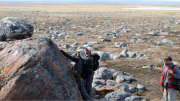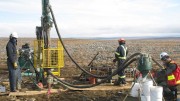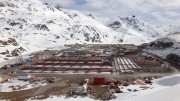Seabridge Gold (TSX: SEA; NYSE: SA) plans to enhance its exploration potential in northwestern B.C.’s Golden Triangle by tucking in junior explorer SnipGold (TSXV: SGG) and its Iskut property, 110 km northwest of Stewart.
Iskut shares geological similarities with Seabridge’s Kerr Sulphurets Mitchell (KSM) project, 65 km northwest of Stewart, which Seabridge describes as the largest undeveloped gold-copper project in the world. The two properties are close enough to offer synergies in both infrastructure and personnel, Seabridge says.
Under the proposed all-share acquisition — valued at nearly $10 million — SnipGold shareholders would receive 1/63 of a common share of Seabridge for every share they hold of SnipGold.
The offer works out to 29.1¢ per share of SnipGold, or a 124% premium, based on the closing price for both companies on April 18, or a 115% premium, based on the trailing 30-day, volume-weighted average trading price.

A drill site at Seabridge Gold’s KSM gold-copper project, 65 km northwest of Stewart, British Columbia. Credit: Seabridge Gold
Under the definitive agreement, Seabridge will also give SnipGold interim debt financing of up to $400,000.
SnipGold’s board of directors and management, which own a combined 24% stake in the company, are voting in favour of the offer.
“Our focus during the downturn in the market has been to look for earn-in partners. But, except for the KSP option agreement with Colorado Resources, we never found anything that would reward SnipGold shareholders,” John Zbeetnoff, SnipGold’s president and CEO, says in an interview.
“We had lots of discussions on earn-ins, but nothing came to fruition. Seabridge didn’t want an earn-in. They wanted to purchase us. It was a good offer that came at a tough time in the market.”
Zbeetnoff notes that if the deal is approved by the company’s remaining shareholders, it will put Iskut into the hands of a mid-tier company that could finance the project with minimal dilution.
“For a project this big, it is going to be capital intensive to explore, and at the bottom of the market, where we are, the dilution SnipGold shareholders would suffer to finance large drill programs would mean losing a lot of value,” Zbeetnoff says. “Having this project move on to Seabridge, where they have the capacity to do significant financing with minimal dilution, is a good thing for our shareholders.”
Seabridge noted in a press release that SnipGold’s shareholders would benefit from gaining exposure to its KSM property and benefit from Seabridge’s more senior exchange listings, and greater liquidity.
The KSM project has proven and probable reserves of 2.2 billion tonnes grading 0.55 gram gold per tonne, 0.2% copper, 2.74 grams silver per tonne and 44.7 parts per million moly for contained metal of 38.2 million oz. gold, 9.9 billion lb. copper, 191 million oz. silver and 213 million lb. molybdenum.
Based on preliminary work, Seabridge envisions a 52-year mine life at KSM. The company received permits to begin early-stage construction in September 2014.
Seabridge shareholders are getting a large project — “it’s more like an area play,” Zbeetnoff says — with a number of drill-ready targets. He and his management team, who joined SnipGold in 2011, after selling Brett Resources and its Hammond Reef project to Osisko Gold Mining in 2010, have spent the last few years putting together all of the data from various property acquisitions by SnipGold’s predecessor company, Skyline Gold Corp.
“Each acquisition brought new land, and its prospects have never been put into a single unified database,” he says. “The showings and various targets were assessed in isolated local grid systems, and there was no way to tie these together without undertaking a significant compilation effort. We can now tie the various targets together … we’ve done a lot of hard work to put this together, and have queued up several drill targets that Seabridge can follow up on.”
One of the most attractive opportunities at Iskut is the Snip-Bronson trend, which lies within 75 to 100 metres of underground development at the past-producing Snip gold mine, now owned by Barrick Gold (TSX: ABX; NYSE: ABX). The trend leads into a large soil geochemical anomaly on SnipGold’s Iskut property. (The anomaly is 5 km long — 2.5 km of which has a soil geochem signature greater than 200 parts per billion gold.)
The project also hosts other drill-ready, high-grade gold targets, including McFadden, where SnipGold identified a geophysical signature that it says could provide high-grade boulders. The boulders have typically assayed at hundreds of grams gold per tonne.
Zbeetnoff notes that the area remains “fairly under-explored” and one of the company’s best intercepts was from hole 29 on the trend, which returned 10 metres grading 10 grams gold per tonne, including 1.4 metres of 56 grams gold per tonne. “It has a signature of heavy sulphide content — a dead ringer for sulphide mineralization at the Snip mine,” he says. “It’s going to need a lot of drilling, but that’s one of our drill-ready targets.”
The project also contains the Bronson Slope porphyry deposit, a few hundred metres east of the Snip gold mine, which has a measured and indicated resource of 186.9 million tonnes grading 0.36 gram gold per tonne, 0.1% copper, 2.19 grams silver per tonne and 5.3% magnetite, for contained metal of 2.16 million oz. gold, 502.7 million lb. copper, 13.17 million oz. silver and 9.9 million tonnes magnetite.
Inferred resources at Bronson Slope add 4.9 million tonnes averaging 0.32 gram gold, 0.1% copper, 2.19 grams silver and 3.7% magnetite, for contained metal of 0.05 million oz. gold, 8.1 million lb. copper, 0.35 million oz. silver and 0.2 million tonnes magnetite.
Meanwhile, 2 to 3 km northwest of the Bronson deposit and Snip mine, downstream on the Iskut River, is the Snip North porphyry. Exploration efforts in the 1980s — in addition to work in 2006–07 — defined a mineralized porphyry gold-copper system with a surface geochemical and geophysical signature in the order of a 2,250-metre trend length and 200 to 300 metres wide. Drill testing (71 historic drill holes) suggests the target is open along strike and open beyond the 200-metre depth already cored. The deposit sub-crops below a thin layer of overburden and glacial cover.
Historic drilling indicates a similar grade to that of the Bronson Slope deposit. And like Bronson, there is a strong magnetic signature associated with the porphyry that the company says can be mapped easily from an airborne magnetics survey it did in 2011.






Be the first to comment on "SnipGold’s Iskut project attracts Seabridge"